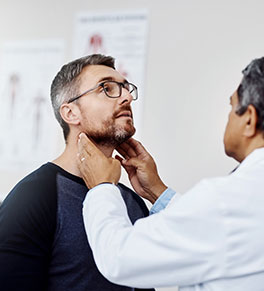HPV-related oral cancers soar among men

Early detection and vaccination for the human papilloma virus (HPV) has led to a drop in cervical cancer in U.S. women, while HPV-associated cancer of the tonsils, throat or back of the tongue have increased exponentially, particularly in men, over the last three decades.
Oropharyngeal cancer has now surpassed cervical cancer as the most common HPV-related malignancy, with more than 21,000 U.S, cases yearly compared to nearly 12,000 cervical cancer cases, according to the U.S. Centers for Disease Control and Prevention (CDC).
“What we’re seeing over the last five to 10 years is that the most common head and neck cancer is HPV-related oropharyngeal cancer,” says Dr. Tjoson Tjoa, a UCI Health otolaryngologist and surgeon who specializes in head and neck cancer.
Throat cancer affects men 4 to 1
In the past, oropharyngeal cancers were typically found in U.S. men in their 70s and 80s who smoked and drank heavily throughout their lives. From 1988 to 2004, however, a three-fold increase in cases among younger men without a history of longtime smoking or drinking pointed to a burgeoning epidemic.
“It’s showing up in men four times as often as in women,” says Tjoa. “It’s occurring primarily in educated white men in the United States and other developed nations, and at much younger ages than we saw previously.”
The cause, says Tjoa, is oral sex and increased exposure to HPV.
“In recent years, this practice has become more prevalent in developed areas of the world,” he explains. “HPV is the most common sexually transmitted disease, so much so that nearly all sexually active men and women are exposed to it.”
Can appear decades after exposure
Most people may get a throat infection from the virus that goes away. But others may go on to develop cancer in the throat, tonsils or tongue 20 to 30 years after exposure.
When a vaccine to prevent HPV was introduced in the United States in 2006, the CDC recommended it for children beginning at age 11 or 12, before they become sexually active. The vaccination campaigns were aimed mainly at girls and women to prevent cervical cancer.
But Tjoa says not enough people made the connection between HPV and throat cancers that were appearing in men and women decades after exposure.
“That’s unfortunate, since it’s potentially completely preventable with vaccination,” says Tjoa. “If 100% of boys were vaccinated before they became sexually active, we wouldn’t have this disease.”
Preventable through vaccines
HPV-related cervical cancer rates declined 50% from 1975 to 2015, due mainly to screening, early detection and vaccination.
Vaccination, which is the only thing that decreases the risk of developing HPV-related cancers, are now approved by the CDC for males and females between the ages of 10½ and 45.
Does it work for people who’ve already been exposed? Tjoa doesn’t think so, but he adds that vaccinations can’t hurt: “It’s better to be safe than sorry.”
The vaccine comes in a number of different strains, but all cover HPV16, which causes 95% of HPV-related cancers.
Signs and symptoms
The most common signs of oral and oropharyngeal cancers are:
- A mouth or lip sore that doesn’t heal
- A red or white patch on the gums, tongue, tonsil or mouth lining
- A lump on the lip, mouth, neck or throat
- A thickening in the cheek
- A persistent sore throat or feeling that something is caught in the throat
- A hoarseness or change in voice
- A numbness of mouth or tongue
- Pain or bleeding in the mouth
- Difficulty chewing or swallowing
- Pain in the jaw or ear
- Chronic bad breath
If you are experiencing any of these symptoms, Tjoa says it’s important to see a doctor immediately. “It’s imperative to catch it as early as possible for the best outcomes.”
Highly treatable cancers
HPV-related oropharyngeal cancers aren’t usually found until they have reached an advanced stage for several reasons.
One, there’s a latency factor, often appearing 20 to 30 years later. Two, they tend to be slow growing. And three, they’re not easy to see inside the mouth and throat, unlike a spot on the hand that may be a skin cancer.
By the time oral or oropharyngeal cancer is recognized — typically when a patient notices a lump on the back of the neck — it already has spread to nearby lymph nodes.
Even so, Tjoa wants men to know that HPV-related oropharyngeal cancer is highly treatable.
While many oral and oropharyngeal cancers are treated successfully with radiation or chemotherapy, he and his fellow UCI Health otolaryngologists are experts in removing them with robot-assisted surgical techniques.
“Our minimally invasive surgical method allows us to effectively remove them, with a short recovery time,” he adds. “We perform three to four of these surgeries each month, with high success rates.”
Related stories
- Revolutionizing prostrate cancer care
- Reimagining cancer care for Orange County
- Ringing the alarm on Lynch syndrome
Explore Further
Browse more blog posts by topic.




